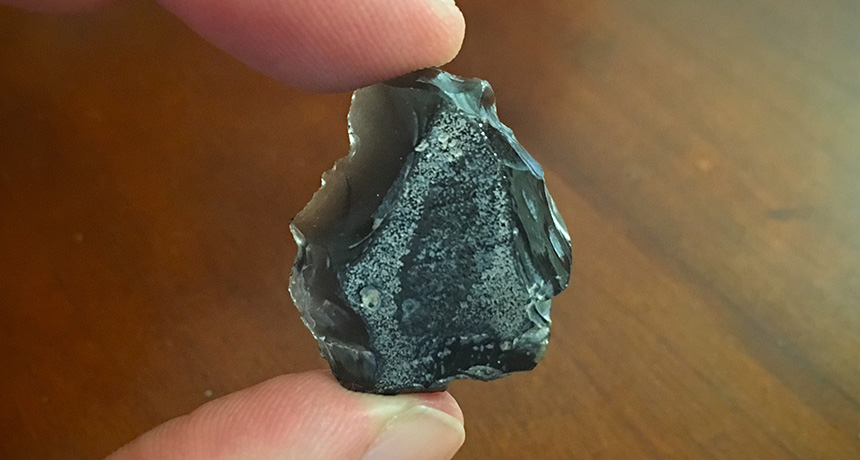Tool sharpens focus on Stone Age networking in the Middle East

A stone tool found in Syria more than 80 years ago has sharpened scientists’ understanding of Stone Age networking.
Small enough to fit in the palm of an adult’s hand, this chipped piece of obsidian dates to between 41,000 and 32,000 years ago, say archaeologists Ellery Frahm and Thomas Hauck. It was fashioned out of volcanic rock from outcrops in central Turkey, a minimum of 700 kilometers from where the artifact was found, the researchers report in the June Journal of Archaeological Science: Reports. Until now, the earliest transport of obsidian into the Middle East was thought to have occurred between 14,500 and 11,500 years ago, when Natufian foragers began to live in year-round settlements (SN: 9/25/10, p. 14).
Someone probably shaped the obsidian chunk into a usable tool near its Turkish source, say Frahm, of Yale University, and Hauck, of the University of Cologne in Germany. The tool, which could have been used for various cutting and scraping tasks, was then passed from one mobile group to another, perhaps several times, before reaching Syria’s Yabroud II rock-shelter. Along the way, the implement underwent reshaping and resharpening.
The most direct path between the Turkish and Syrian sites stretches about 700 kilometers. But hunter-gatherers meander, following prey animals and searching for other food. So, Stone Age bearers of the obsidian tool probably traveled considerably farther to reach one of several rock-shelters clustered near what’s now the Syrian town of Yabroud, the investigators say. “They didn’t type ‘Yabroud’ into a GPS unit and make their way to the rock-shelter as fast as possible,” Frahm says.
Excavations at the Yabroud sites between 1930 and 1933 yielded the obsidian tool and hundreds of artifacts made from a type of rock called chert found a mere five to 10 kilometers away. Some researchers suspect the obsidian tool was mistakenly included among much older finds shortly after being excavated. But a copy of the lead excavator’s book describing his fieldwork, housed at Yale, confirms that the implement was found in sediment dating to around the time ancient humans and Neandertals inhabited the Middle East, Frahm says. Since excavators did not collect material for radiocarbon dating, Frahm and Hauck estimated the Syrian rock-shelter’s age by comparing its sediment layers and artifacts with those at several nearby, better-dated sites.
Neandertals survived in the Middle East and elsewhere until at least 40,000 years ago (SN: 9/20/14, p. 11), so they might have been the final recipients of the obsidian tool. But Frahm considers Homo sapiens a better candidate. Humans occupied the Middle East and nearby regions throughout the period when the tool may have been used. No hominid fossils have been recovered at the Syrian site.
Using a portable X-ray device, Frahm and Hauck determined the chemical composition of the obsidian tool and 230 obsidian samples from known sites throughout southwestern Asia. That let the researchers match the Syrian find to its Turkish source.
Outside the Middle East, previous evidence suggested that long-distance obsidian transport occurred in Stone Age Eurasia. Researchers reported in 1966 that two obsidian pieces with sharpened edges found at northern Iraq’s Shanidar Cave originated roughly 450 kilometers to the north. That analysis used an earlier technique for measuring a stone’s chemical composition. Shanidar’s obsidian finds date to about the same time as that of the Yabroud II obsidian tool, perhaps to as early as 48,000 years ago, Frahm says.
Recent investigations of obsidian artifacts at late Stone Age sites in Eurasia not far from Shanidar Cave, in what’s now Armenia and Georgia, indicate that hunter-gatherers there also exploited vast territories, says archaeologist Daniel Adler of the University of Connecticut in Storrs. Frahm has contributed to some of that research. As for the Yabroud II obsidian tool, “a 700-kilometer transport distance is fully within the realm of possibility for a single person over an extended period of time,” Adler says.
Eurasia may have a far older tradition of extensive hunter-gatherer networking than the Middle East does. Evidence of long-distance obsidian transport in Armenia dates to as early as around 500,000 years ago, notes archaeologist Andrew Kandel of the University of Tübingen in Germany. That means Neandertals or other now-extinct hominid species first transported obsidian across hundreds of kilometers, he says.